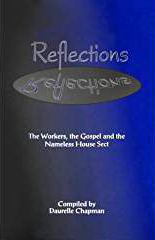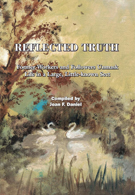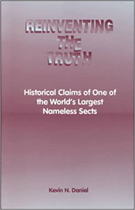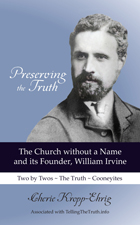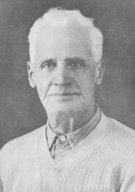The exact year the workers went to Italy for the first time is not known for certain. One of the first workers to go to Italy was Alexander Scott (also known as Sandy), from Scotland. He went sometime after World War I ended, in 1924 at the latest, but perhaps before that. Robert Marshall was in Italy by 1924 and they were likely Sandy companions. The 1929 Italy Workers list shows six brother workers: Sandy Scott, Virgil Simpson, Peter McKeever, Sam Dawson, Edwin Mills and Reg Beer.
Sadie Marshall and Florrie List are also shown on the 1929 Italy Workers list. Ruth Lemons and Emma Neuendorf joined them by 1930. Lucy Hiscock and Alexa Roberts by 1932. Natalina Vairos, an Italian sister worker from the village of Carema labored in Italy 1935–1938. She was preaching in the Italian province of Pescara with Lucy Hiscock and Sadie Marshall when the Fascist police forced them to move. [Source: Document from the Prefettura di Pescara to the Ministero dell'Interno, dated March 10, 1935] (AS PE, Atti Prefettura 1930-1935, https://www.triangoloviola.it/stitalia8.html). A nephew stated that "she died in the 1980s" and that to his knowledge, "she was a member of your congregation till her death." She may have actually been the first Italian to start in the work.
The FIRST Italians to profess lived in a town called Picciano, a town inland from Pescara about 15 miles. There were eight people there who accepted God’s Truth and Way.
At that time, there was no Italian convention in Italy. The friends at Picciano told the workers they would like to have an Italian convention. Some of the friends had been to a convention in Switzerland, but someone had to interpret what was said in meetings to them, because the conventions in Switzerland were and still are spoken in either German or French. As a rule, the Swiss can speak German, French and English. A small part of Switzerland has Italian as its main language, and there is a Sunday A.M. meeting there.
The workers got busy and made a few ticks; bought some pots and pans and a stove; and made some seats. A 40’ x 20’ tent was brought from U.S.A., and they held the FIRST Italian convention in Picciano. Counting children and neighbors, there were around 30 who attended, and some decided. Convention continued to be held there in Picciano for 44 years, until the place became too crowded for the 400 plus who attended. Then some friends bought land farther South and built a large home with help from some Americans, Canadians, and Swiss, and convention is still being held there.
In 1933, Sandy Scott and Otto Kemich were the first workers to go to Spain to labor
Like most of the European workers with American roots (Sandy had worked in America before going to Italy), he returned to the USA where he was actively in the work. After the war ended, and as soon as it was practical, many workers returned to the various European countries where they were laboring before the War broke out. Sandy returned to Italy where he was the overseer and he continued in that role.
Florrie List evidently returned soon after the war and was there until 1982, when she returned to England, where she died in 1988. Lucy Hiscock also returned after the war and spent the rest of her life there, passing away in 1974. Three Italian sisters who are still alive and active in the work must have started shortly after the war, since they are on the first post-war lists.
In 1948, Sandy Scott and Reg Beer had a mission in a mountain village in Northern Italy called Carema, where several women decided. The brother workers thought it would be best if some sister workers were to teach the ladies in this town and help get them established. So Edna Powell from Alberta, Canada and Virginia Micheletti went to preach in Italy for the first time. Virginia and her mother had been to Italy in 1948 to visit her mother’s people who lived in Northern Italy near the Swiss border, not far out of Turin. (Virginia started in the work in 1934.) The women in Carema found two rooms where the two sister workers could live and hold gospel meetings, even though their Italian wasn’t much at that time.
A convention was established in Carema, Italy, and it is still held there; 200 or more attend. The daughter of one of the Carema ladies and her husband own the convention place. They have a three-story house. Convention meetings are on the ground floor and their living quarters are above this. At convention time, places for sleeping are found in the village. The convention place is located on a busy road that leads to the mountains where many people from the cities go for vacations, so the heavy traffic made it too noisy to use a tent for meetings. For the convention in Italy, there are always Swiss workers, and some Italian workers go to the conventions in Switzerland. At the Italy conventions in the South, some 470 come, and in the North some 200 attend.
Reportedly, Sandy felt it might be easier to be accepted in some of the Italian villages as a married couple, rather than two single men. So sometime in the early 1950s, Sandy married Eva Idso, who was an American sister worker from Iowa laboring in Italy. Eva was 28 years younger than Sandy. Sam Dawson then assumed the role of Overseer of Italy, due to the policy that no overseer could be married.
NOTE: Some of the above information was summarized from letters written by Virginia Micheletti
ALEXANDER (Sandy) SCOTT (1886-1968) Professed in 1909 in Scotland. Labored in Scotland, USA, Canada; pioneered the work in Spain in 1933; and went to Italy after WWI ended. Sometime in the 1950's, Sandy married Eva Idso, who was an American sister worker from Iowa laboring in Italy. Eva was 28 years younger than Sandy. Sandy wrote many hymns found in Hymns Old & New. He died November 26, 1968, aged 82, and is buried near Chelan, in Okanogan Co., Washington, US. He is shown on Workers List for Italy in 1956. Eva Scott was born in 1914 and passed away October 11, 2010, and is buried in Iowa, US.
When did the workers first arrive? Early 1920s
Who were the first brother workers? Alexander Scott (Scotland) and Robert Marshall
Who were the first sister workers? Sadie Marshall and Florrie List
Who was the first to profess? 8 people who lived in Picciano
Who was the first native to go in the work? (Possibly) Natalina Vairos in 1935.
When & Where was the first meeting? Picciano; date------?
When & Where was the first convention? Held at Picciano for 44 years; Date of 1st conv------??
Where is the convention currently held? Carema (Torino) and Petacciato (Campobasso), Italy
Who have the Overseers been?
Sandy Scott, from Scotland, was the first overseer of Italy. Died May 3, 1968.
Succeeded by Sam Dawson, from Ireland in the 1950's. Died in 1992
Succeeded by Graham Snow, from New Zealand until 1997 who went to be Overseer of Switzerland when Willy Geiser died.
Succeeded by David Butterworth from England in 1997, who is the current Overseer
Italian Website titled "Two-by-Two's
TTT Editor's Note: In the absence of a written account, the above information has been compiled by the TTT Editor from various sources. Corrections or additions are most welcome; as well as other historical accounts for this country Email TTT
About Italy
Italy has long been one of the most well-known and influential countries in the world, famous all out of proportion for its size. Its art, music, literature, food, culture, and architecture have had enormous influence all over the world. It receives more tourists than any other country in Europe because of the incredible richness of its history, with perhaps more sights, monuments, ruins, and places of historical interest than anywhere else in the continent.
Because of its fame, importance, and popularity, one tends to think of it as an ancient nation. But Italy is not an old country; in fact it is much younger than the United States. Up until 1870, the familiar boot-shaped peninsula was not one unified nation, like France, Spain, and England had already been for centuries. It was a collection of many small kingdoms, duchies, republics, principalities, and theocracies, with ever-changing borders and frequent disputes and wars among them. At various times, Naples, Venice, Genoa, Rome, Pisa, and Florence were all in separate independent countries. The Duchy of Savoy, the Republic of Lucca, the Marquisate of Mantua, the Papal States, the Republic of Siena, the Bishopric of Trent, the Kingdom of Piedmont, and the Duchy of Ferrara were all separate nations; though practically forgotten now, some of them were very important and powerful in their time.
Even though each area had, and still has, its own dialect (sometimes incomprehensible to other areas), the standard Italian literary language began to be used all over the peninsula for ease of communication, and tended to give these various nation-states more unity than they would have otherwise had. So there was some sense of “Italian-ness” to the citizens of the various regions, and cooperation and alliance among the various nations became more often the rule than the exception. Italy has much more logical and less arbitrary borders than most countries of the world, being bounded by the sea on most sides, and by the Alps across most of the north. So there was always a concept of an overall geographical “ Italy”, even though the inhabitants owed their primary allegiance to the various small countries it was divided into.
However, the fractured nature of this collection of small states made Italy quite vulnerable to attack from countries to the north, which from the 1700’s on were quickly industrializing and becoming more powerful. In the 1800’s, Austria was one of the largest and strongest countries in Europe, rivaling France and England in its power ( Germany at the time was even more fractured into separate small countries than Italy was). Austria soon conquered much of northern Italy, including Venice and Milano, and had designs on more and more of the peninsula. The south was conquered by Spain, and France controlled Rome for a while. But this foreign domination of course angered the Italians, proud of their ancient and often glorious history, and had the effect of unifying the various regions against their enemies.
It was not easy to unify the many separate regions into a large, new, unified country – few ruling parties, kings, or dukes, much less popes (who controlled central Italy for centuries with all the power of kings, or more), would willingly give up their power, throne, or kingdom, even for the greater good of the whole. But over the course of the middle 1800’s, with considerable bloodshed and struggle, unity was achieved and modern Italy was born. A king was chosen, Victor Emanuel, who ruled the new nation from 1861 until his death in 1878. His son, grandson, and great-grandson all became later kings, with the last, Umberto II, being forced to abdicate in 1946 after WWII, when Italy became a republic.
Italy was recently calculated to have the 8 th highest quality of life index in the world, surpassing the USA, Canada, Japan, France, Germany, and the UK. The average income of its citizens equals or surpasses that of France and the UK also; however its wealth is not evenly distributed, as the south is still rather poor, because of its relative isolation from the rest of the continent, being distant from the main centers of population and commerce in the rest of Europe. The far north is extremely prosperous, with cities such as Milano and Torino being among the industrial and cultural powerhouses of the European Union. Also some of the continent’s finest agricultural land is along the great Po River valley in northern Italy, famous for its cheeses, wines, and meat products.
Because of the lack of national unity in Italy’s history, no one giant city has ever totally dominated the country, like Paris in France or London in England. Instead it has several large important cities, all of which were capitals at some point in their long histories. Rome has the largest population within its city limits, but Milano’s metropolitan population is twice as large as Rome’s. Naples is almost as large as Rome, but Florence and Venice get more tourists because of their art and architecture.
There are two small remnants of Italy’s fractured past still in existence. The tiny countries of San Marino and the Vatican are still independent nations, with their own flags and governments, though totally surrounded by modern-day Italy. In 1957, Italy became one of the founding members of the European Union.
Roman Catholicism is by far the largest religion in the country, although the Catholic Church is no longer officially the state religion. 87.8% of Italians identify as Roman Catholic although only about one-third of these describe themselves as active members (36.8%). Other Christian groups in Italy include more than 700,000 Eastern Orthodox Christians, 550,000 Pentecostals and Evangelicals, of whom 400,000 are members of the Assemblies of God. There are 235,000 Jehovah's Witnesses, 30,000 Waldensians, 25,000 Seventh-day Adventists, 22,000 Mormons, 20,000 Baptists, 7,000 Lutherans, and 5,000 Methodists. The country's oldest religious minority is the Jewish community, comprising roughly 45,000 people. As a result of immigration from other parts of the world, some 825,000 Muslims (1.4% of the total population) live in Italy, though only 50,000 are Italian citizens. In addition, there are 110,000 Buddhists and 70,000 Hindus in Italy.
"About Italy" written by Galen Berry, Oct. 2010
TTT Editor's Note: In the absence of a written account, the above information has been compiled by the TTT Editor from various sources. Corrections or additions are most welcome; as well as other historical accounts for this country Email TTT

 REPRESENTING THE LARGEST COLLECTION OF 2X2 HISTORICAL DOCUMENTS ON THE INTERNET
REPRESENTING THE LARGEST COLLECTION OF 2X2 HISTORICAL DOCUMENTS ON THE INTERNET
 Perry, Oklahoma Conv, 1942
Perry, Oklahoma Conv, 1942
